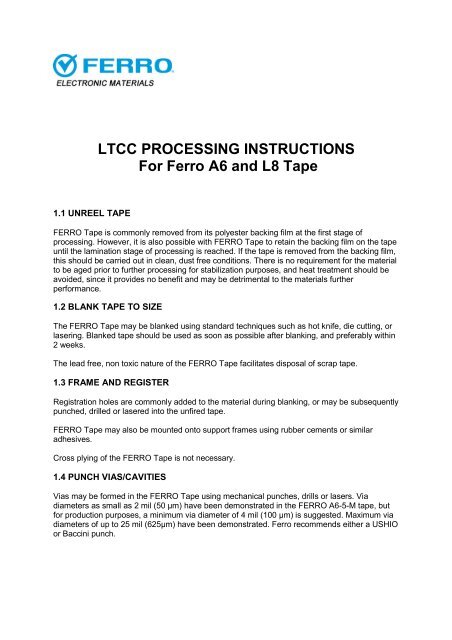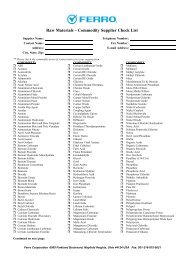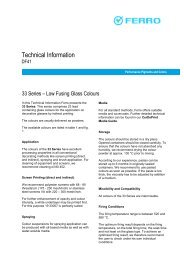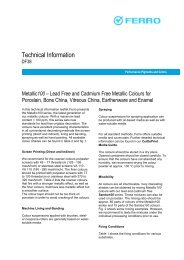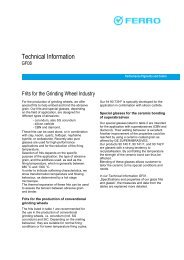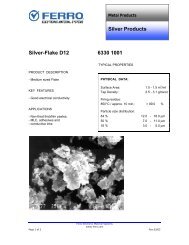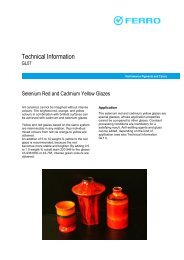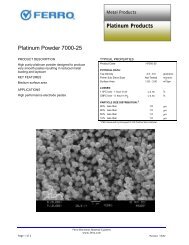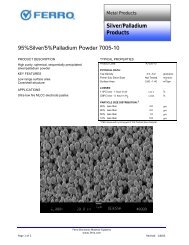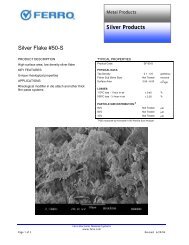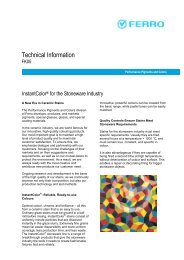LTCC PROCESSING INSTRUCTIONS For Ferro A6 and L8 Tape
LTCC PROCESSING INSTRUCTIONS For Ferro A6 and L8 Tape
LTCC PROCESSING INSTRUCTIONS For Ferro A6 and L8 Tape
You also want an ePaper? Increase the reach of your titles
YUMPU automatically turns print PDFs into web optimized ePapers that Google loves.
1.1 UNREEL TAPE<br />
<strong>LTCC</strong> <strong>PROCESSING</strong> <strong>INSTRUCTIONS</strong><br />
<strong>For</strong> <strong>Ferro</strong> <strong>A6</strong> <strong>and</strong> <strong>L8</strong> <strong>Tape</strong><br />
FERRO <strong>Tape</strong> is commonly removed from its polyester backing film at the first stage of<br />
processing. However, it is also possible with FERRO <strong>Tape</strong> to retain the backing film on the tape<br />
until the lamination stage of processing is reached. If the tape is removed from the backing film,<br />
this should be carried out in clean, dust free conditions. There is no requirement for the material<br />
to be aged prior to further processing for stabilization purposes, <strong>and</strong> heat treatment should be<br />
avoided, since it provides no benefit <strong>and</strong> may be detrimental to the materials further<br />
performance.<br />
1.2 BLANK TAPE TO SIZE<br />
The FERRO <strong>Tape</strong> may be blanked using st<strong>and</strong>ard techniques such as hot knife, die cutting, or<br />
lasering. Blanked tape should be used as soon as possible after blanking, <strong>and</strong> preferably within<br />
2 weeks.<br />
The lead free, non toxic nature of the FERRO <strong>Tape</strong> facilitates disposal of scrap tape.<br />
1.3 FRAME AND REGISTER<br />
Registration holes are commonly added to the material during blanking, or may be subsequently<br />
punched, drilled or lasered into the unfired tape.<br />
FERRO <strong>Tape</strong> may also be mounted onto support frames using rubber cements or similar<br />
adhesives.<br />
Cross plying of the FERRO <strong>Tape</strong> is not necessary.<br />
1.4 PUNCH VIAS/CAVITIES<br />
Vias may be formed in the FERRO <strong>Tape</strong> using mechanical punches, drills or lasers. Via<br />
diameters as small as 2 mil (50 μm) have been demonstrated in the FERRO <strong>A6</strong>-5-M tape, but<br />
for production purposes, a minimum via diameter of 4 mil (100 μm) is suggested. Maximum via<br />
diameters of up to 25 mil (625μm) have been demonstrated. <strong>Ferro</strong> recommends either a USHIO<br />
or Baccini punch.
1.5 FILL VIAS<br />
STENCILS<br />
At <strong>Ferro</strong> Electronic Materials, 3 mil thick brass stencils are used on an AMI printer, MP9156, to<br />
fill vias. The brass is punched on a Ushio MP7150 punch using tight tolerance dies with 5μm<br />
clearance <strong>and</strong> brass bottomed strippers. The brass is lightly oiled before punching <strong>and</strong> usually<br />
is punched twice to ensure good cone-free holes.<br />
The punched brass is mounted in a 12” x 12” frame on a stainless steel 325 mesh screen. First,<br />
the brass is cut to size <strong>and</strong> glue is spread on one side around the edge of the brass in a b<strong>and</strong><br />
about 1/2-inch wide. The brass is then pressed into the center of the bottom of the screen <strong>and</strong><br />
weights are put on the screen to ensure good contact of the brass <strong>and</strong> screen while the glue<br />
dries.<br />
After the glue has dried, the screen mesh is cut away from on top of the stencil. Some thin tape,<br />
such as Scotch tape, can be used to smooth the cut edge of the screen.<br />
PRINTER<br />
The printer used at <strong>Ferro</strong> Electronic Materials has a porous stone base through which a vacuum<br />
can be pulled. A backing paper is always used between the stone <strong>and</strong> the tape layer.<br />
The printer parameters are important. These are:<br />
PRINTING<br />
Squeegee 90 durometer, diamond 3/8 inches.<br />
Squeegee Set in the squeegee “down position” with the screen removed. The printer<br />
Pressure stage with paper <strong>and</strong> tape in place is positioned under the squeegee <strong>and</strong><br />
the squeegee pressure adjusted to 7.5 psi.<br />
Downstop This can be left open.<br />
Squeegee Set to 0.6 inches per second in both directions.<br />
Speed<br />
Print Mode Use print/print mode, i.e., print in both directions for each filling of vias.<br />
Vacuum Use 20-25 inches Hg. It is important that areas of the stone outside the<br />
tape <strong>and</strong> backing paper are covered to prevent vacuum leakage. Mylar<br />
can be used for this.<br />
Snap-Off With stencil in place, bring the screen slowly down until the vacuum just<br />
pulls it on to the stone with tape <strong>and</strong> backing paper on it. Then use this as<br />
zero set-point <strong>and</strong> make snap-off at 25 mils.<br />
Vias are filled using the print/print printer mode. After printing, the paper must stay in place<br />
beneath the tape during the drying stage to ensure good vias. So carefully lift the paper <strong>and</strong><br />
tape together from the printer stone stage <strong>and</strong> place in drying oven. Dry for 30 minutes at 70°C.<br />
Then pull tape from the paper. Only a very minor amount of paste will remain on the paper. Via<br />
filling is typically accomplished using modified on or off contact printing with metal or plastic
ased stencils. A vacuum pull through is typically used on the printing stage, <strong>and</strong> backing paper<br />
is typically used for backing the film during the via filling operation. Purpose built bladder type<br />
via filling equipment may also be used with the FERRO <strong>Tape</strong> <strong>and</strong> Via fill paste systems. Precise<br />
via filling conditions will depend on the number, size <strong>and</strong> mix of vias to be filled, <strong>and</strong> should be<br />
determined experimentally.<br />
1.6 DRY<br />
After completion of via filling the parts should be dried (backing paper still supporting the tape)<br />
in conventional drying ovens at a maximum temperature of 70°C for 20 to 30 minutes.<br />
1.7 PRINT CONDUCTORS<br />
Conductors are printed onto the tape using conventional screen printing techniques <strong>and</strong><br />
recommended screens (see individual product data sheets). Conductor prints may be dried in<br />
conventional drying ovens at a maximum temperature of 70°C for 10 minutes.<br />
1.8 DRY<br />
Dry in conventional drying ovens at a maximum temperature of 70°C for 10 to 20 minutes.<br />
1.9 PRINT RESISTORS<br />
All co-fireable resistors are printed onto the unfired tape using #325 screens. Target dried<br />
thickness is 25-28 μm. The resistors should be dried in conventional drying ovens at a<br />
maximum temperature of 70°C for 10 minutes.<br />
1.10 DRY<br />
Dry in conventional drying ovens at a maximum temperature of 70°C for 10 to 20 minutes.<br />
1.11 STACK LAYERS<br />
All layers should be inspected for visual acceptance <strong>and</strong> collated.<br />
1.12 INSERTS FOR CAVITY FORMATION<br />
Some general guidelines are offered in “<strong>Ferro</strong> <strong>LTCC</strong> H<strong>and</strong>ling <strong>and</strong> Design Recommendations.”<br />
These must be followed for best results.<br />
There are four principal types of cavity.<br />
1. Cavity with vertical walls but closed at bottom.<br />
2. Cavity with stepped walls, closed at bottom.<br />
3. Through cavity.
4. Through cavity with stepped walls.<br />
One other type of cavity has been produced <strong>and</strong> is a major problem to control. This cavity has a<br />
floor that is not at the bottom of the laminate, i.e. the cavity bottom is only supported where it<br />
joins the walls.<br />
At <strong>Ferro</strong> Electronic Materials the preferred approach to cavity formation is to punch the cavity<br />
layers before any metallization steps (vias, conductors, resistors). Because punching is used<br />
cavity geometries are limited to rectangular shapes with rounded corners.<br />
It must be recognized that removal of much of a tape layer for cavities can seriously weaken the<br />
green sheet <strong>and</strong> cause difficulties during subsequent processing. One approach to overcome<br />
this problem is to punch the tape cavities after metallization. Frames for this have been<br />
produced by UHT. Results using this method at <strong>Ferro</strong> Electronic Materials have not been good<br />
because alignment of vias were never as good as with the single punching step.<br />
PROCESS STEPS<br />
1. Punch each layer of tape. This punching will make both via holes <strong>and</strong> cut out the<br />
cavity.<br />
2. Fill vias.<br />
3. Print conductors.<br />
4. Print cofiring resistors.<br />
5. Stack layers on registration fixture.<br />
6. Put inserts in cavities (see below for inserts). Do not use top plate.<br />
7. Vacuum bag.<br />
8. Laminate.<br />
9. Remove from vacuum bag <strong>and</strong> remove from registration fixture.<br />
10. Remove inserts.<br />
11. Trim part to size.<br />
12. Fire.<br />
Some of the above steps may not be necessary, e.g. some layers may have no vias.<br />
INSERTS<br />
Inserts are essential to prevent the cavities from distortion during lamination. At its simplest this<br />
distortion will result in rounded cavity wall edges. At the most extreme, cavities will tend to close<br />
up <strong>and</strong> the bottom of the cavity will lift.<br />
The through cavities are easiest to deal with. Here inserts can be made from hard materials that<br />
can be machined to give a good fit.<br />
With other types of cavity the <strong>Ferro</strong> Electronic Materials preferred material for inserts is Silastic<br />
J RTV from Dow Corning. These inserts are made by preparing a dummy part with cavities but
no metallization, etc. Only minimum pressure is used to laminate this dummy part to avoid any<br />
cavity distortion. With <strong>Ferro</strong> <strong>Tape</strong>, 1000 psi has typically been used.<br />
Once the dummy laminate has been prepared, the Silastic J is cast in the cavities <strong>and</strong> allowed<br />
to cure. After curing, the inserts are removed <strong>and</strong> cleaned <strong>and</strong> are then ready for use.<br />
Other materials that can be used for inserts are pieces of latex <strong>and</strong> other soft rubber. Latex<br />
must be accurately cut to size however.<br />
STEPPED WALLS<br />
It is important to underst<strong>and</strong> that a major problem can arise with stepped walls. This occurs if<br />
inserts are too stiff <strong>and</strong> do not compress enough during the lamination step. Consequently the<br />
steps can receive greater or lesser pressure than the bulk of the laminate <strong>and</strong> during firing<br />
shrink at a different rate.<br />
A similar effect can occur with cavity bottoms if a top plate is used on the registration fixture that<br />
over compresses Silastic J or latex.<br />
1.13 LAMINATION<br />
Lamination may be carried out in either isostatic or uniaxial laminators. However, lamination is<br />
critical in achieving consistent green density, <strong>and</strong> hence consistent shrinkage, hermeticity <strong>and</strong><br />
electrical performance, <strong>and</strong> <strong>Ferro</strong> strongly recommends the use of isostatic lamination, which<br />
has been demonstrated to give the most consistent results.<br />
Recommended lamination conditions are a pressure of 3000 psi, a temperature of 70°C with a<br />
10 minute dwell time –no pressure followed by a lamination time of 10 minutes.<br />
<strong>Ferro</strong> will provide Lamination Pressure vs. Lamination Density curves for each lot of <strong>Ferro</strong> <strong>Tape</strong><br />
as a reference guide for processing.<br />
1.14 BURN-OUT / FIRING<br />
Organic burn out may be combined with the firing operation in both box <strong>and</strong> tunnel furnaces, or<br />
may be performed as a separate step.<br />
The unfired laminates are heated, on their setters, at a rate of 2°C/minute to peak temperature<br />
of 450°C, which should be maintained for a minimum of 2 hours, to ensure complete<br />
combustion of all organics. This burn out procedure should be considered a starting point,<br />
although it should be more than adequate for most requirements; fine tuning of the burnout<br />
procedure will depend on part size, number of layers, <strong>and</strong> amount of metallization.
<strong>For</strong> <strong>A6</strong> <strong>Tape</strong> use the following profile:<br />
Ramp for 450°C to 850°C at 6-8C per minute followed by a 10 minute dwell at 850C. The air<br />
flow should be set at 100 SCFH. It is critical that <strong>A6</strong> see 850C for a minimum of 10 minutes<br />
<strong>A6</strong> <strong>Tape</strong> Burn out & Firing Profile<br />
TemperatureC<br />
900<br />
800<br />
700<br />
600<br />
500<br />
400<br />
300<br />
200<br />
100<br />
25C<br />
St<strong>and</strong>ard Bakeout <strong>and</strong> Firing Profile for <strong>Ferro</strong> <strong>A6</strong>S <strong>Tape</strong> System<br />
450C<br />
0<br />
0 100 200 300 400 500 600 700<br />
450C<br />
Time in Minutes<br />
850C<br />
Firing Profile is 6C - 8C per minute from 450C-850C with a minimum 10 minute soak<br />
Bakeout Profile is 2C per minute from 250C to 450C with a 2 hour soak<br />
<strong>For</strong> <strong>L8</strong> <strong>Tape</strong> choose from the following profiles:<br />
Box- Ramp for 450°C to 850°C at 4- 8C per minute followed by a 30 minute dwell at 850C<br />
Belt- 16’ (7) Zone furnace with a 0.5” /minute belt speed <strong>and</strong> a set point of 850C –see <strong>L8</strong><br />
Belt profile below –contact <strong>Ferro</strong> for specific Zone air flow <strong>and</strong> temperature settings<br />
25C
<strong>L8</strong> <strong>Tape</strong> Burn out & Firing Profile Box Furnace<br />
Temperature C<br />
900<br />
800<br />
700<br />
600<br />
500<br />
400<br />
300<br />
200<br />
100<br />
0<br />
St<strong>and</strong>ard Bakeout <strong>and</strong> Firing Profile for <strong>Ferro</strong> <strong>L8</strong>- Box Kiln<br />
Firing Ramp Rate is 4C - 8C per minute from 450C - 850C with a 30 minute soak<br />
Bakeout Profile is 1C* per minute from 25C to 450C with a 2 hour soak<br />
* Bakeout ramp adjusted to 1C /min for Thicker Parts > 50-mils<br />
0 100 200 300 400 500 600<br />
Time in Minutes<br />
450C<br />
Parts less than 50 mils can generally use a 2C ramp for Bakeout depending<br />
upon metal loading<br />
<strong>L8</strong> <strong>Tape</strong> Burn out & Firing Profile Belt Furnace<br />
Temperature C<br />
900<br />
800<br />
700<br />
600<br />
500<br />
400<br />
300<br />
200<br />
100<br />
<strong>L8</strong> Belt Profile<br />
0<br />
0 50 100 150 200 250 300 350 400 450<br />
Time Minutes
1.15 FIRING<br />
RECOMMENDED SETTTERS<br />
Fused quartz for either <strong>L8</strong> or <strong>A6</strong> . Bare alumina setters are ok for <strong>L8</strong> but should not be used for<br />
<strong>A6</strong>M. In some cases Zirconia felt is better for full coverage ground plane metallization parts to<br />
improve air flow <strong>and</strong> reduce hot spots <strong>and</strong> ultimately warpage.<br />
RECOMMENDED SUPPLIERS<br />
Fused Quartz GE 124, 16 micro inch surface: Behm Quartz Industries,<br />
www.behmquartz.com 800.543.7875<br />
Zirconia Felt: Zicar Fibrous Ceramics, Part No. ZYF-50, Tel: 800.245.2562<br />
Alumina Setters, 96% Alumina, Coorstek www.coorstek.com<br />
1.16 CLEANING<br />
There is no cleaning solution for tape. Particulates are typically removed with an anti-static<br />
brush. We recommend using only reagent grade acetone for cleaning fired parts.
<strong>LTCC</strong> DESIGN<br />
RECOMMENDATIONS<br />
2.1 CONDUCTOR LAYOUT<br />
Conductor width <strong>and</strong> spacing<br />
A B C<br />
preferred 30 mils 20 mils 10 mils<br />
possible 4 mils 4 mils 4 mils<br />
Product Resistance normalized<br />
to 25.4 microns<br />
(mΩ/sq.)<br />
<strong>A6</strong> & <strong>L8</strong> All Au<br />
FX 30-025
<strong>L8</strong> All Ag<br />
CN33- 498 Ag
2.2 GROUND AND POWER PLANES<br />
IC Bonding Fingers<br />
FEATURE SURFACE PLANE BURIED PLANES<br />
SOLID GROUND/POWER<br />
PLANE<br />
COMPLETE COVERAGE 100 MIL WIDE STRIPS MAX<br />
GRID SIZE 10 MIL CONDUCTOR 10 MIL CONDUCTOR<br />
15 MIL SPACING<br />
15 MIL SPACING<br />
CASTELLATION N/A AT EDGES OF PART OR<br />
AT CAVITY WALL<br />
CASTELLATION<br />
N/A ENDS >10 MILS FROM<br />
CLEARANCE<br />
EDGE OR WALL<br />
GROUNDING<br />
N/A ENDS EXTEND >10 MILS<br />
CASTELLATION<br />
PAST EDGE<br />
FEED THROUGH<br />
CLEARANCE<br />
20 MILS ALL SIDES 20 MILS ALL SIDES<br />
TAPE LAYERS ABOVE OR OFFSET SPACE AND OFFSET SPACE AND<br />
BELOW GRID PLANES LINES BY 12 MILS<br />
LINES BY 12 MILS<br />
X-Y<br />
X-Y
2.3 CAVITIES
2.4 ELECTRICAL VIAS<br />
Electrical via to edge of substrate.<br />
Via<br />
A<br />
Recommended<br />
Thickness<br />
Diameter<br />
Min<br />
Punch Method<br />
2 mil >10 mil 25 mil Punch<br />
4-10 20 mil Punch<br />
10 mil 25 mil Punch<br />
4-10 20 mil Punch<br />
10 mil 25 mil Punch<br />
4-10 20 mil Punch<br />
2.6 THERMAL VIAS<br />
Product<br />
Dimensions of Thermal Via <strong>and</strong> Catch Pad<br />
Thermal Conductivity<br />
(W/m-k)<br />
Thermal<br />
Resistance<br />
<strong>A6</strong><br />
CN 30-078 (Au) >50
Thermal Hexagonal Via Pattern: Six mil vias only<br />
Thermal Rectangular Via Pattern: 6 or 10 mil vias
2.7 RESISTORS<br />
Technical Specification 87 Series Resistor System <strong>For</strong> <strong>A6</strong> <strong>Tape</strong><br />
Tolerance Hot TCR Cold TCR<br />
Resistor Type Ohms/square Specification (ppm/°C) (ppm/°C)<br />
FX 87-011 Buried 10 ±30% - -<br />
FX 87-011 Surface 10 ±30% - -<br />
FX 87-101 Surface 100 ±30% ±450 ±450<br />
FX 87-101 Buried 100 ±30% ±450 ±450<br />
FX 87-102 Surface 1000 ±30% ±200 ±200<br />
FX 87-102 Buried 1000 ±30% ±200 ±200<br />
FX 87-103 Surface 10,000 ±30% ±200 ±200<br />
FX 87-103 Buried 10,000 ±30% ±200 ±200<br />
Resistor Layout <strong>and</strong> Probe Area Layout
Resistor to conductor termination overlaps for surface <strong>and</strong> buried resistors<br />
Minimum Spacing Maximum Spacing<br />
Layout<br />
(mils)<br />
(mils)<br />
A 10 15<br />
B 15 20<br />
C 10 10
2.7 Resistors-cont.<br />
Ohms<br />
120<br />
100<br />
80<br />
60<br />
40<br />
20<br />
0<br />
Blending of the 87 Series<br />
Blend curve for 87-101Series Resistor Material with<br />
% Additions of 87-011 (40 x 40 mil resistor)<br />
0 20 40 60 80 100<br />
Percent by weight of 87-011


